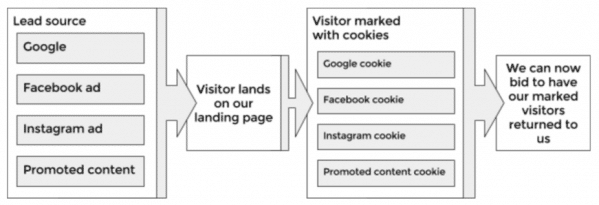All things equal – Which of the following scenarios using Google Adwords, would you prefer for your business:
- Have 100 “first-time visitors” come to your website.
- Have 100 “repeat visitors” return to your website.
Why Bring Them Back? The Case for Returning Leads
“Why bother chasing folks who didn’t buy?” is a question we hear often.
The answer is that for most businesses it takes multiple exposures to an offer for a lead to mature into a customer. Since returning leads are obviously more interested in your offer, they’re also more likely to make a purchase, and are therefore more valuable.
Remarketing Gets You Returning Leads
In order to expose your business, and bring new potential customers, we use direct advertising campaigns using platforms like Google Adwords as mentioned in our previous post. When we want leads attracted by your campaign to return for another visit to your website, we use Remarketing Cookies to meet the desired Effective Frequency.
We covered the logic for favouring returning visitors earlier. Now let’s explain the lingo:
Explaining Effective Frequency
Effective Frequency is the average number of times your potential customer must be exposed to your offer, before making an order. How many times must your website be visited to be effective and get the sale?
Your Effective Frequency is affected by the product/service you’re selling, and how well they’re being presented on your site. This has very pragmatic implications to your ad spend – Better landing pages are more likely to convert leads into customers with fewer visits which means your cost for converting these leads is lower.
Explaining Remarketing Cookies
Remarketing Cookies are markers affixed to your visitors’ browsers when they come to your website/landing page for the first time. They contain is a tracker enabling us to follow the actions on that visitor’s browser, but no personal identification details about them.
Remarketing Cookies are available from the major online advertising platforms, and allow tracking a user for considerably long periods:
- Google’s cookie lasts 150 days
- Facebooks’ cookie lasts 180 days.
Remarketing – Step by Step

We bid for our audience on our campaign platform. On Adwords for example that means going after all our relevant keywords – even the expensive ones.
As soon as a visitor arrives on our landing page the remarketing cookie is attached allowing us to now bid on the platform for exposure specifically to those marked targets hoping to return them to our website for a 2nd visit.
This is a continuous progress – we keep optimizing the cost of first timers, repeat visitors etc. Eventually this process yields profound difference in user-acquisition-rates (the cost of converting a visitor to a customer / lead). See the example below:

Remarketing for SMEs
Remarketing is one of those cool online opportunities that gives SMEs an opportunity to level the playing field and compete with large corporations on equal terms.
The simplest way to get into the game is suitable even for players with small daily budgets and modest organic traffic. By adding remarketing cookies to their website, SMEs can bid with Google and Facebook to return those visitors who have already visited the site once and are therefore more likely to convert into leads. How effective it is? Well, if you found us via a Google or Facebook ad, chances are that’s how you arrived here…


